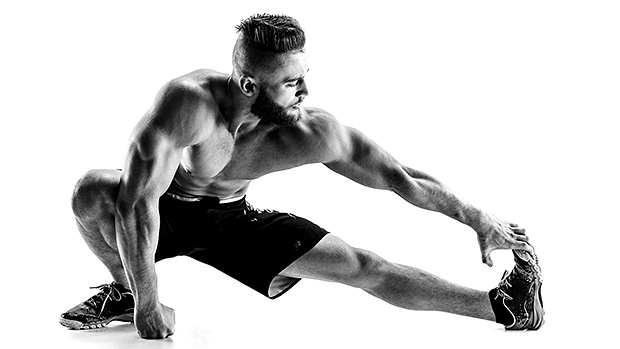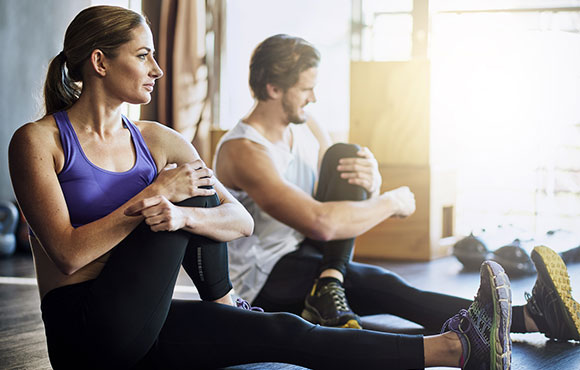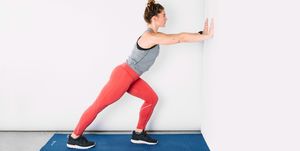Test your stretching knowledge with a short quiz.
Every one of us can agree that it’s tough to run with stiff, tight muscles. Not only that, but you could be setting yourself up for injury if you make it a habit. So stretching regularly to maintain or improve your muscles’ flexibility and range of motion—and avoid getting sidelined—is extremely important.
But the question remains: Should you stretch before or after your run? Test yourself below to see how much you know about when and how to stretch.
The answer: Stretch—but make sure it’s dynamic.
Stretching Before Running
Stretching has been hotly debated in recent years. There is no evidence that static stretching—the act of lengthening muscles and tendons to increase flexibility by holding one position—prevents injury or improves performance, experts now say. In fact, there’s some evidence that it can actually do more harm than good.
“Static stretching before exercise causes damage to the tissue,” says physical therapist Jason Gromelski, owner of Nola Physical Therapy in New York City. “You’re inhibiting nerve contraction, so it’s not going to fire as quickly to tell the muscle to contract and perform. That leads to less force production, so your speed will go down.”
When it comes to staying injury-free, functional range of motion is more important than flexibility. That’s where dynamic stretching—active movements that stretch your muscles without staying in one position for too long (think: Frankenstein walk vs. touching your toes and holding it)—comes in.

Before your run, your time is better spent warming up with dynamic stretching for 10 to 15 minutes. These moves—which include exercises such as butt kicks, high knees, leg swings, or even a light jog—improve range of motion and loosen up muscles that you’re going to use on the road. They also increase heart rate, body temperature, and blood flow so you feel warmed up sooner and run more efficiently. “Before you exercise, you want to get blood to the muscles, which get them warmed up and ready to go,” Gromelski says.
Try incorporating these moves into your next prerun warmup.
Frankenstein Walk
How to: Start standing with feet together. Extend right leg straight out in front of you as you bring left hand to tap right toes. Lower leg and step forward; repeat on opposite side. Continue for 30 seconds.
Quad + Piriformis Walk
How to: Start standing then draw left foot up behind you, pulling it toward your butt for a quad stretch. Release and step forward; switch legs. After 30 seconds, cradle right leg at ankle and knee and pulling it up to chest. Release and step forward; switch legs. Repeat for 30 seconds.
Inchworm
How to: From standing, bend forward at the waist to touch toes, then walk hands out to a high plank. Hold for 2 seconds; walk feet to meet hands. Roll up to starting position. Repeat for 1 minute.
The answer: Yes, stretching postrun will help loosen any tight muscles.
Stretching After Running
It’s also important to stretch afterward. If you have an area that still feels tight—the calves, hamstrings, hip flexors, IT bands, and quads tend to be tight after running—a quick cooldown stretching routine may be in order.
“The only benefit to doing static stretches is to increase range of motion. But that’s why you do it after exercise—you already have the blood in your muscles, and now you can get a real nice, deep stretch in and lengthen your muscles,” he says.
[Want to start running? The Big Book of Running for Beginners will take you through everything you need to know to get started, step by step.]
Try these stretches after a run that can be done anywhere.
Quad Stretch
How to: While standing, shift weight to right leg, bring your left heel back, and grab your left foot or ankle with your left hand. Gently pull your foot toward your tailbone. Keep your knees aligned, and pelvis tucked; don’t arch your back. Repeat on other side.
Calf Stretch
How to: Stand facing a wall, tree, or some similar structure for support with left foot forward and both hands flat against a wall, arms fully extended. Keeping both heels on ground, lean forward with left knee tracking over left toes. Make sure both feet are facing forward. Hold for one to two counts, then repeat. After 20 reps, repeat on left leg.
Whether you’re doing static or dynamic stretches, they should give you the feeling of slight discomfort in the muscle, however, do not stretch to the point that you feel a sensation that is painful, sharp, or intense. If you do, be sure to back off.
“You shouldn’t be in pain,” Gromelski says. “It should be a bit uncomfortable because the point is that you have to have physiological changes to the muscle for it to benefit.”





Recent Comments